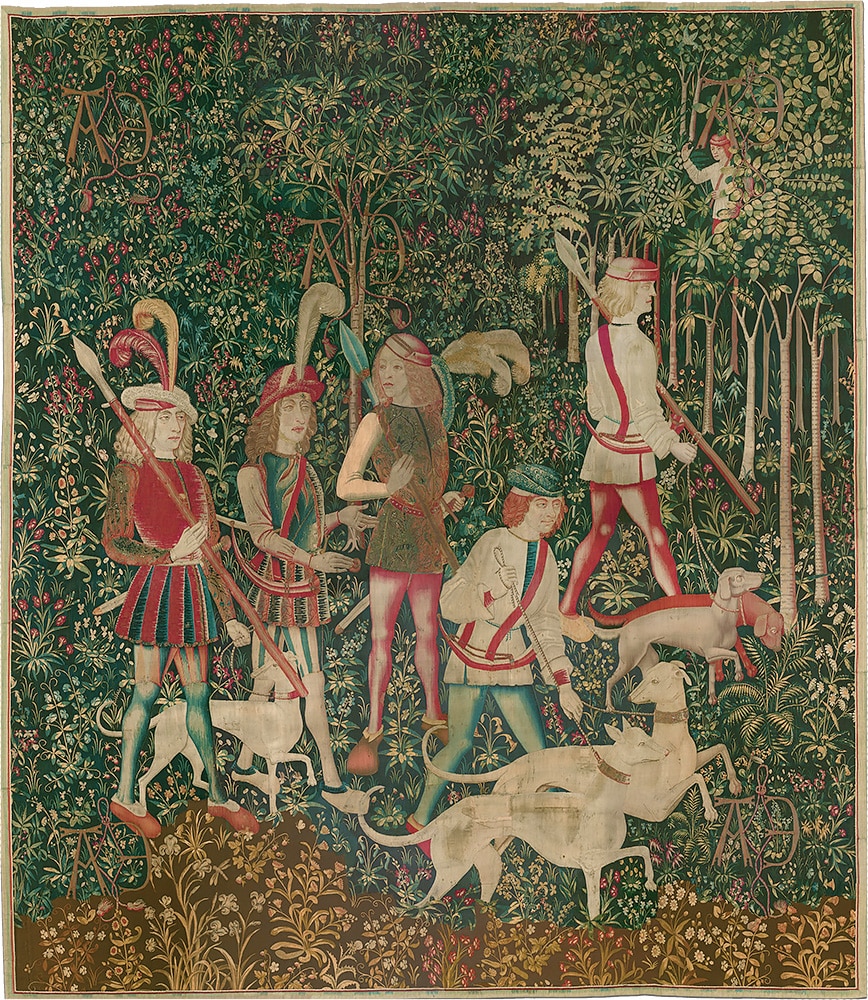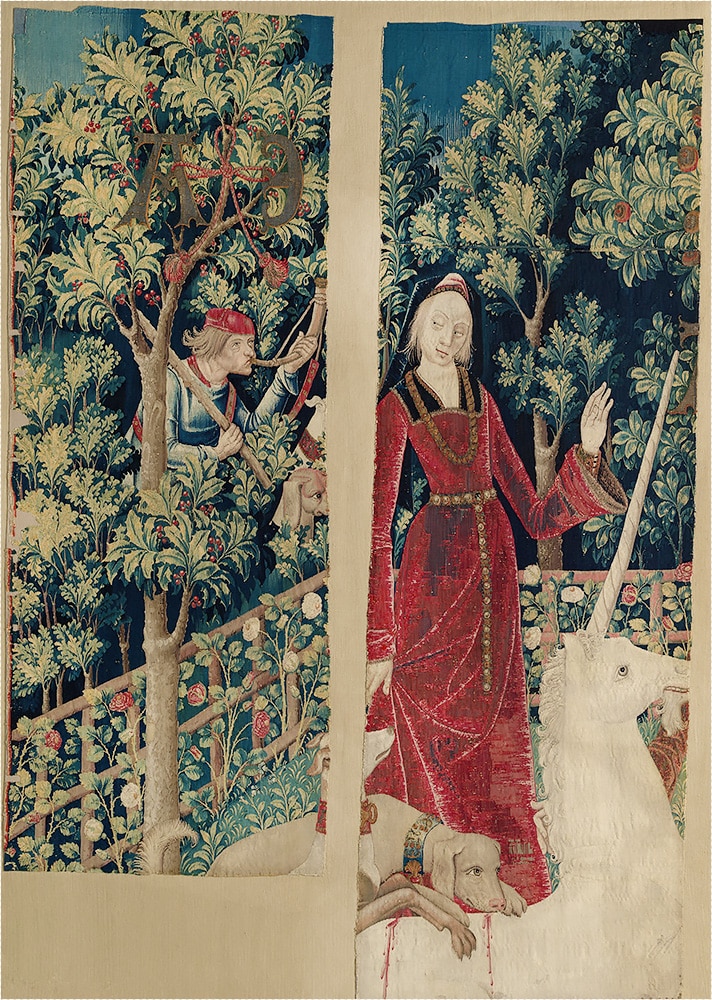Lets Explore The Facinating History Of The Iconic Unicorn Tapestries
Shop Our Beautiful Tapestry Collection | Learn How To Hang A Tapestry Or Rug On The Wall
You May Also Want To Review: How To Hand Historical Biblical Tapestries | What Are Historical Tapestries? | Verdure Tapestries | Gobelin Tapestry History| Kesi: The History of the Chinese Tapestry | History of the Bayeux Tapestry | William Baumgarten and The Aubusson Tapestries | History of the Beauvais Tapestries | Barberini Tapestries Reborn from the Ashes | Green Tapestries Vogue 2017 Home Decor | Alighiero Boetti Tapestries
What are the unicorn tapestries?
Arguably the most famous tapestries in the world, the Unicorn Tapestries are a serie of tapestries that depict a hunting expedition where hunters pursue a mythical unicorn through a forest. Each tapestry in the series presents a different scene in the hunt, showcasing various stages of the chase and depicting the unicorn’s capture and subsequent demise. Alongside the unicorn, the tapestries also feature other animals, plants and human figures.
What makes these tapestries particularly intriguing is their rich symbolism and interpretation. In these tapestries, the unicorn is portrayed as a noble and elusive creature, hunted by men but eventually captured and killed only to return once again.

What Are The Unicorn Tapestries?
What makes the unicorn tapestries so significant?
The Unicorn Tapestries are celebrated for their remarkable weaving technique, vibrant colors and detailed designs. They feature meticulous renderings of flora and fauna, intricate patterns and elaborate borders. The use of gold and silver thread further enhances their beauty and richness.
These tapestries hold a significant place in art history and continue to captivate viewers with their enigmatic allure. They represent the pinnacle of medieval textile artistry and serve as a testament to the skill and craftsmanship of the weavers who created them.
How many tapestries make up the unicorn tapestry series?
The Unicorn Tapestries comprise a series of seven individual tapestries. Each tapestry presents a different scene in the hunt for the mythical unicorn. The seven tapestries together form a cohesive narrative, depicting various stages of the hunt, capturing the unicorn, and ultimately its demise.
The sequence of the Unicorn Tapestries is as follows:
- The Start of the Hunt: This tapestry introduces the hunt, featuring hunters and hounds entering a forest setting.

The Start Of The Hunt For The Unicorn
- The Unicorn at the Fountain Purifies Water: Here, the unicorn is discovered near a fountain, purifying the water with his horn, symbolizing purity and rejuvenation.

The Unicorn At The Fountain
- The Unicorn Crosses a Stream And Is Attacked: The unicorn is attacked by the hunters as he crosses a river in an attempt to flea – symbolizing triumph of evil forces over the virtuous.

The Unicorn Is Attacked by The Hunters As He Crosses a Stream
- The Unicorn Defends Itself: The unicorn fiercely defends itself against the hunters, displaying its strength and resilience.

The Unicorn Defends Itself
- The Unicorn Is Tamed: The unicorn is depicted resting by a maiden while dogs lick the wounds on his back, representing its submission and taming.

The Unicorn Is Tamed by a Maiden
- The Unicorn Killed and Brought to the Castle: Here, the hunters successfully capture, kill and bring it back to the castle – this is often symbolic of Christ’s Passion.

The Unicorn Is Killed and Brought To The Castle
- The Unicorn Rests in a Garden: The final tapestry portrays the unicorn, alive once again, and happily confined within an enclosure – probably represents fertility and marriage

The Unicorn In Captivity
Together, these seven unicorn tapestries create a narrative sequence that tells the story of the unicorn hunt. Each tapestry contributes to the overall narrative and captures different moments in the hunt, showcasing the symbolism and artistry associated with the Unicorn Tapestries.
When were the unicorn tapestries made?
The Unicorn Tapestries are medieval tapestries from the late 15th century. They were woven around 1495–1505 which correlates to the late medieval or early / high Renaissance period.
What is another name for the unicorn tapestries?
The “Unicorn” Tapestries are also known as “The Hunt of the Unicorn”.
What is the meaning behind the Unicorn Tapestries?
The Unicorn Tapestries are rich in symbolism and have been the subject of much interpretation and speculation. While the exact intended meaning remains a subject of debate within the art history world, several prevailing theories attempt to uncover the meaning of symbolism behind these captivating antique tapestries.
Here are some common interpretations of the meaning behind the unicorn tapestries:
- Christian Allegory: One interpretation suggests that the Unicorn Tapestries carry Christian allegorical themes. The unicorn, often seen as a symbol of purity and Christ himself, could represent the Incarnation or the Passion of Christ. The hunt and capture of the unicorn may symbolize the Crucifixion, while its death and subsequent resurrection might represent the Resurrection of Christ.
- Medieval Romance and Chivalry: The tapestries could be seen as a reflection of medieval romance and chivalric ideals. They present a narrative of a noble pursuit, showcasing knights and hunters engaged in a quest for a mythical creature. The tapestries celebrate the ideals of chivalry, courtly love and the pursuit of the unattainable.
- Moral and Moralizing Themes: The tapestries may also convey moral and didactic messages. The unicorn’s capture and death could symbolize the transient nature of worldly pleasures or the consequences of sinful actions. The narrative may serve as a cautionary tale or moral lesson, encouraging virtuous behavior and warning against the dangers of temptation.
- Fertility and Marriage: Another interpretation suggests that the unicorn represents fertility and the tapestries depict a symbolic union between the unicorn and a maiden. The hunt could be viewed as a metaphorical pursuit of love or the journey towards marital union and the consummation of marriage.
- Secular Aristocratic Symbolism: The tapestries might also reflect the opulence and prestige of the aristocracy during the medieval period. They could be regarded as an expression of wealth, power and luxury, showcasing the patron’s status and their ability to commission such elaborate works of art.
It is important to note that these interpretations are speculative and the true intended meaning behind the Unicorn Tapestries may never be definitively known. The tapestries’ enigmatic nature adds to their allure, allowing viewers to engage with their beauty and symbolism in a personal and subjective manner.
Where did the unicorn tapestry come from / where were they woven?
The exact origin of the unicorn tapestries is uncertain and their precise place of production origin remains a topic of scholarly debate. That said, there are several theories regarding their creation.
Some scholars suggest that the tapestries were woven in the southern Netherlands (present-day Belgium) based on stylistic characteristics and similarities to other Flemish tapestries of the time. Others propose that they were produced in France, possibly in Paris or the regions of Flanders or Tournai.
Who commissioned the Unicorn Tapestries to be woven originally?
The specific patron who commissioned the unicorn tapestries and the purpose for which they were made remain uncertain. That said, the tapestries were likely commissioned by a wealthy noble or royal patron, given their exquisite craftsmanship and the expense involved in creating such large and intricate tapestries.
Where are the Unicorn Tapestries found today?
The tapestries passed through several hands and were owned by various collectors over the centuries. They were acquired by the American art collector John D. Rockefeller Jr. in 1922 and later donated to the Metropolitan Museum of Art in New York City. Today, the Unicorn Tapestries are housed in the Cloisters museum, a part of the Metropolitan Museum of Art, where they continue to be admired by visitors from around the world. The Cloisters is a specialized museum dedicated to medieval art and culture.
The Unicorn Tapestries are displayed in a specially designed gallery within the Cloisters, offering visitors an immersive and atmospheric setting to experience these remarkable works of art. The museum provides a serene environment that complements the tapestries’ medieval origins and allows visitors to appreciate their intricate details, vibrant colors and symbolism.
The Cloisters museum itself is situated in Fort Tryon Park in upper Manhattan, overlooking the Hudson River. The building itself is inspired by medieval architecture, evoking a sense of stepping into a medieval European monastery or castle. In addition to the Unicorn Tapestries, the museum houses a wide range of medieval artworks, including sculptures, paintings, stained glass and architectural elements.
Visitors to the Cloisters can explore the museum’s collection, admire the Unicorn Tapestries up close, and learn more about medieval art and culture. The tapestries continue to captivate audiences with their elusively enigmatic allure, providing a glimpse into the rich artistic heritage of the medieval period.
What did the unicorn symbol mean or represent during the medieval or early / high Renaissance period
In the medieval and early / high Renaissance period, the unicorn held significant symbolic meaning. It was a creature deeply rooted in mythology, folklore, Christian allegory and its symbolism evolved over time.
Here are some key interpretations of the unicorn symbol during the medieval or early / high Renaissance period:
- Purity and Virginity: The unicorn was often associated with purity and virginity. It was believed that only a pure and virtuous maiden could tame or capture a unicorn. In Christian symbolism, the unicorn came to represent Christ and his incarnation, with the unicorn’s horn representing the unity of divine and human nature.
- Christ and Redemption: The unicorn was sometimes seen as a Christological symbol. Its capture and sacrifice were interpreted as parallels to the crucifixion of Christ and his redemptive sacrifice for humanity’s sins. The unicorn’s death and subsequent resurrection were associated with Christ’s resurrection and the promise of salvation.
- Chastity and Spiritual Love: The unicorn’s association with purity also extended to concepts of chastity and spiritual love. Its presence in artwork and literature often conveyed the ideal of courtly love and the pursuit of a noble and unattainable beloved.
- Heraldic Symbolism: The unicorn frequently appeared in heraldry, serving as a symbol of strength, courage and nobility. It was often depicted as a fierce and powerful creature, emphasizing its role as a prestigious emblem for knights and noble families.
- Unattainable and Elusive Desires: The unicorn was seen as a symbol of the unattainable and the pursuit of desires that were difficult to achieve. It embodied the longing for something extraordinary, magical, or elusive and the quest to capture or possess it.
The interpretation of the unicorn symbol varied across different cultures and contexts and its meaning could be influenced by individual beliefs, religion and artistic representations. Nonetheless, the unicorn’s symbolism in the medieval and Renaissance period was often tied to concepts of purity, spirituality, redemption and the pursuit of higher ideals.
This post about the ionic Unicorn Tapestries was published by Nazmiyal Antique Rugs



